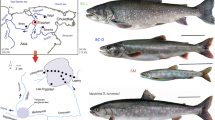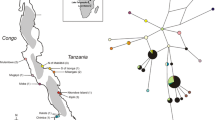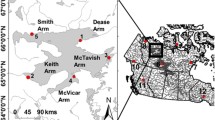Abstract
Lake Lanao on Mindanao island is the largest freshwater lake in the Philippines and may represent one of the few ancient lakes in Southeast Asia. This lake’s fauna is best known for its endemic cyprinid fishes that have been nearly driven to extinction through various anthropogenic actions. In contrast, only little is known about Lake Lanao’s invertebrate fauna and its placement within related Southeast Asian taxa. We here focus on the diversity in freshwater molluscs, particularly the morphologically diverse viviparid gastropods, and provide first genetic insights into this group in order to test whether the morphological variability observed is also reflected by corresponding genetic variation. Mitochondrial sequence data indicate that these viviparids form a monophyletic group comprising morphologically distinct and partly genetically different (morpho)species. Both the high diversity found in cyprinid fishes and viviparid gastropods together with the geological and tectonic evolution of Mindanao suggest that Lake Lanao may have originated more than 100,000 years ago and is thus indeed an ancient lake. However, its fauna is under continuous threat not least from the introduction of non-native species, and the development and implementation of sustainable conservation strategies is direly needed.



Similar content being viewed by others
References
Adam, B., 2010. L’Anodonte chinoise Sinanodonta woodiana (Lea, 1834) (Mollusca, Bivalvia, Unionidae): une espèce introduite qui colonise le bassin Rhône-Méditerranée. MalaCo 6: 278–287.
Albrecht, C., O. Kroll, E. Moreno Terrazas & T. Wilke, 2009. Invasion of ancient Lake Titicaca by the globally invasive Physa acuta (Gastropoda: Pulmonata: Hygrophila). Biological Invasions 11: 1821–1826.
Albrecht, C., K. Föller, C. Clewing, T. Hauffe & T. Wilke, 2014. Invaders versus endemics: alien gastropod species in ancient Lake Ohrid. Hydrobiologia 739: 163–174.
Bartsch, P., 1907. The Philippine pond snails of the genus Vivipara. Proceedings of the United States National Museum 32: 135–150.
Bartsch, P., 1909. Notes on the Philippine pond snails of the genus Vivipara, with descriptions of new species. Proceedings of the United States National Museum 37: 365–367.
Bolotov, I. N., Y. V. Bespalaya, M. Y. Gofarov, A. V. Kondakov, E. S. Konopleva & I. V. Vikhrev, 2016. Spreading of the Chinese pond mussel, Sinanodonta woodiana, across Wallacea: one or more lineages invade tropical islands and Europe. Biochemical Systematics and Ecology 67: 58–64.
Brooks, J. L., 1950. Speciation in ancient lakes. Quarterly Review of Biology 25(30–60): 131–176.
Burch, J. B., 1984. Freshwater snails of the Philippines. Walkerana 2: 81–112.
Clement, M., D. Posada & K. A. Crandall, 2000. TCS: a computer program to estimate gene genealogies. Molecular Ecology 9: 1657–1659.
Cohen, A. S., 2012. Scientific drilling and biological evolution in ancient lakes: lessons learned and recommendations for the future. Hydrobiologia 682: 3–25.
Cristescu, M. E., S. J. Adamowicz, J. J. Vaillant & G. D. Haffner, 2010. Ancient lakes revisited: from the ecology to the genetics of speciation. Molecular Ecology 19: 4837–4851.
Du, L., J. Yang, T. Rintelen, X. Chen & D. Aldridge, 2013. Molecular phylogenetic evidence that the Chinese viviparid genus Margarya (Gastropoda: Viviparidae) is polyphyletic. Chinese Science Bulletin 58: 2154–2162.
Folmer, O., M. Black, W. Hoeh, R. Lutz & R. Vrijenhoek, 1994. DNA primers for amplification of mitochondrial cytochrome c oxidase subunit I from diverse metazoan invertebrates. Molecular Marine Biology and Biotechnology 3: 294–299.
Frey, D. G., 1969. A limnological reconnaissance of Lake Lanao. Verhandlungen des Internationalen Verein Limnologie 17: 1090–1102.
Genner, M. J., E. Michel, D. Erpenbeck, N. de Voogd, F. Witte & J. P. Pointier, 2004. Camouflaged invasion of Lake Malawi by an Oriental gastropod. Molecular Ecology 13: 2135–2141.
Glaubrecht, M., N. Brinkmann & J. Pöppe, 2009. Diversity and disparity “down under”: systematics, biogeography and reproductive modes of the “marsupial” freshwater Thiaridae (Caenogastropoda, Cerithioidea) in Australia. Zoosystematics and Evolution 85: 199–275.
Gorthner, A., 1994. What is an ancient lake? In Martens, K., G. Coulter & B. Goddeeris (eds), Speciation in Ancient Lakes. E.Schweizerbart’sche Verlagsbuchhandlung, Stuttgart: 97–100.
Greenwood, P. H., 1984. What is a species flock? In Echelle, A. A. & I. Kornfield (eds), Evolution of Fish Species Flocks. University of Maine Press, Orono: 13–19.
Haas, F., 1939. Malacological notes. Zoological Series of Field Museum of Natural History 24: 93–103.
Hall, R., 1996. Reconstructing Cenozoic SE Asia. In Hall, R. & D. J. Blundell (eds), Geological Society, London, Special Publications. Geological Society, London: 153–184.
Herre, A. W. C. T., 1924. Distribution of the true fresh-water fishes in the Philippines. I. The Philippine Cyprinidae. Philippine Journal of Science 24: 249–307.
Herre, A. W. C. T., 1926. Two new fishes from Lake Lanao. Philippine Journal of Science 29: 499–503.
Herre, A. W. C. T., 1932. Five new Philippine fishes. Copeia 1932: 139–142.
Ismail, G. B., D. B. Sampson & D. L. G. Noakes, 2014. The status of Lake Lanao endemic cyprinids (Puntius species) and their conservation. Environmental Biology of Fishes 97: 425–434.
Köhler, F., M. Seddon, A. E. Bogan, V. T. Do, P. Sri-Aroon & D. Allen, 2012. The status and distribution of freshwater molluscs of the Indo-Burma region. In Allen, D. J., K. G. Smith & W. R. T. Darwall (eds), The Status and Distribution of Freshwater Biodiversity in Indo-Burma. IUCN, Cambridge: 67–89.
Kroll, O., R. Hershler, C. Albrecht, E. M. Terrazas, R. Apaza, C. Fuentealba, C. Wolff & T. Wilke, 2012. The endemic gastropod fauna of Lake Titicaca: correlation between molecular evolution and hydrographic history. Ecology and Evolution 2: 1517–1530.
Kumar, S., G. Stecher & K. Tamura, 2016. MEGA7: molecular evolutionary genetics analysis version 7.0 for bigger datasets. Molecular Biology and Evolution 33: 1870–1874.
Lee, T., S. Siripattrawan, F. Ituarte & D. O. Foighil, 2003. Invasion of the clonal clams: Corbicula lineages in the New World. American Malacological Bulletin 20: 113–122.
Martens, K., 1997. Speciation in ancient lakes. Trends in Ecology & Evolution 12: 177–182.
Messager, M. L., B. Lehner, G. Grill, I. Nedeva & O. Schmitt, 2016. Estimating the volume and age of water stored in global lakes using a geo-statistical approach. Nature Communications 7: 13603.
Michel, E., 1994. Why Snails Radiate: A Review of Gastropod Evolution in Long-Lived Lakes, Both Recent and Fossil Speciation in Ancient Lakes. E. Schweitzerbart’sche Verlagsbuchhandlung, Stuttgart: 284–317.
Myers, G. S., 1960. The endemic fish fauna of Lake Lanao, and the evolution of higher taxonomic categories. Evolution 14: 323–333.
Palumbi, S. R., D. M. Hillis, C. Moritz & B. K. Mable, 1996. Nucleic Acids II: The Polymerase Chain Reaction. Molecular Systematics. Sinauer, Sunderland: 205–247.
PHIVOLCS, 2015. Distribution of Active Faults and Trenches in the Philippines. Department of Science and Technology (DOST), Philippine Institute of Volcanology and Seismology (PHIVOLCS), Quezon.
Pigneur, L.-M., J. Marescaux, K. Roland, E. Etoundi, J.-P. Descy & K. Van Doninck, 2011. Phylogeny and androgenesis in the invasive Corbicula clams (Bivalvia, Corbiculidae) in Western Europe. BMC Evolutionary Biology 11: 147.
Pubellier, M., R. Quebral, C. Rangin, B. Deffontaines, C. Muller, J. Butterlin & J. Manzano, 1991. The Mindanao Collision Zone: a soft collision event within a continuous Neogene strike-slip setting. Journal of Southeast Asian Earth Sciences 6: 239–248.
QGIS Development Team, 2017. QGIS Geographic Information System. Open Source Geospatial Foundation Project. https://www.qgis.org/en/site.
Rosagaron, R. R., 2001. Lake Lanao: its past and present status. In Santiago, C. B., M. L. Cuvin-Aralar & Z. U. Basiao (eds), Conservation and Ecological Management of Philippine Lakes in Relation to Fisheries and Aquaculture. SEAFDEC, Bangkok: 29–39.
Rossiter, A. & H. Kawanabe, 2000. Ancient Lakes: Biodiversity, Ecology and Evolution. Advances in Ecological Research. Academic Press, San Diego.
Salzburger, W., B. Van Bocxlaer & A. S. Cohen, 2014. Ecology and evolution of the African Great Lakes and their faunas. Annual Review of Ecology, Evolution and Systematics 45: 519–545.
Santos-Borja, A. C., 1994. The control of saltwater intrusion into Laguna de Bay: socioeconomic and ecological significance. Lake and Reservoir Management 10: 213–219.
Schön, I. & K. Martens, 2004. Adaptive, pre-adaptive and non-adaptive components of radiations in ancient lakes: a review. Organisms Diversity and Evolution 4: 137–156.
Schön, I., C. Poux, E. Verheyen & K. Martens, 2014. High cryptic diversity and persistent lineage segregation in endemic Romecytheridea (Crustacea, Ostracoda) from the ancient Lake Tanganyika (East Africa). Hydrobiologia 739: 119–131.
Schultheiß, R., T. Wilke, A. Jørgensen & C. Albrecht, 2011. The birth of an endemic species flock: demographic history of the Bellamya group (Gastropoda, Viviparidae) in Lake Malawi. Biological Journal of the Linnean Society 102: 130–143.
Seehausen, O., 2006. African cichlid fish: a model system in adaptive radiation research. Proceedings of the Royal Society of London B 273: 1987–1998.
Sherbakov, D. Y., 1999. Molecular phylogenetic studies on the origin of biodiversity in Lake Baikal. Trends in Ecology & Evolution 14: 92–95.
Shu, F., F. Köhler, C. Fu & H. Wang, 2013. A new species of Gyraulus (Gastropoda: Planorbidae) from ancient Lake Lugu, Yunnan-Guizhou Plateau, Southwest China. Molluscan Research 33: 34–39.
Stelbrink, B., A. A. Shirokaya, K. Föller, T. Wilke & C. Albrecht, 2016. Origin and diversification of Lake Ohrid’s endemic acroloxid limpets: the role of geography and ecology. BMC Evolutionary Biology 16: 273.
Strong, E., O. Gargominy, W. Ponder & P. Bouchet, 2008. Global diversity of gastropods (Gastropoda; Mollusca) in freshwater. Hydrobiologia 595: 149–166.
Vaillant, J. J., G. D. Haffner & M. E. Cristecu, 2011. The ancient lakes of Indonesia: towards integrated research on speciation. Integrative and Comparative Biology 51: 634–643.
Vermeij, G. J. & A. P. Covich, 1978. Coevolution of freshwater gastropods and their predators. American Naturalist 112: 833–843.
von Rintelen, T., K. von Rintelen & M. Glaubrecht, 2010. The species flocks of the viviparous freshwater gastropod Tylomelania (Mollusca: Cerithioidea: Pachychilidae) in the ancient lakes of Sulawesi, Indonesia: the role of geography, trophic morphology and color as driving forces in adaptive radiation. In Glaubrecht, M. (ed.), Evolution in Action. Springer, Berlin: 485–512.
von Rintelen, T., K. von Rintelen, M. Glaubrecht, C. D. Schubart & F. Herder, 2012. Aquatic biodiversity hotspots in Wallacea: the species flocks in the ancient lakes of Sulawesi, Indonesia. In Gower, D. J., K. G. Johnson, J. E. Richardson, B. R. Rosen, L. Rüber & S. T. Williams (eds), Biotic evolution and environmental change in Southeast Asia. Cambridge University Press, Cambridge: 290–315.
Wagner, B. & T. Wilke, 2011. Evolutionary and geological history of the Balkan lakes Ohrid and Prespa. Biogeosciences 8: 995–998.
West, K. & A. S. Cohen, 1996. Shell microstructure of gastropods from Lake Tanganyika, Africa: adaptation, convergent evolution, and escalation. Evolution 50: 672–681.
Winnepenninckx, B., T. Backeljau & R. De Wachter, 1993. Extraction of high molecular weight DNA from molluscs. Trends in Genetics 9: 407.
Woltereck, R., 1941. Die Seen und Inseln der “Wallacea”-Zwischenregion und ihre endemische Tierwelt. Zweiter Teil: Inseln und Seen der Philippinen. Internationale Revue der Hydrobiologie 41: 37–176.
Yumul, G. P., C. B. Dimalanta, V. B. Maglambayarw & E. J. Marquez, 2008. Tectonic setting of a composite terrane: a review of the Philippine island arc system. Geosciences Journal 12: 7–17.
Zhang, Z., S. Schwartz, L. Wagner & W. Miller, 2000. A greedy algorithm for aligning DNA sequences. Journal of Computational Biology 7: 203–214.
Zhang, L.-J., S.-C. Chen, L.-T. Yang, L. Jin & F. Köhler, 2015. Systematic revision of the freshwater snail Margarya Nevill, 1877 (Mollusca: Viviparidae) endemic to the ancient lakes of Yunnan, China, with description of new taxa. Zoological Journal of the Linnean Society 174: 760–800.
Zielske, S., M. Glaubrecht & M. Haase, 2011. Origin and radiation of rissooidean gastropods (Caenogastropoda) in ancient lakes of Sulawesi. Zoologica Scripta 40: 221–237.
Zieritz, A., A. E. Bogan, E. Froufe, O. Klishko, T. Kondo, U. Kovitvadhi, S. Kovitvadhi, J. H. Lee, M. Lopes-Lima, J. M. Pfeiffer, R. Sousa, T. Van Do, I. Vikhrev & D. T. Zanatta, 2018. Diversity, biogeography and conservation of freshwater mussels (Bivalvia: Unionida) in East and Southeast Asia. Hydrobiologia 810: 29–44.
Acknowledgements
We particularly thank H.O. Faisal, A.B. Magarang, A.E. Mangondaya and L.G. Serad (SALLAM, Inc.), H.W. Macaayong, H.R.M. Naga and M.-S. Naga (Mindanao State University, Marawi City, Philippines), S.R.K. Adiong and B.A. Mamainte Jr. (Al Khalifa Foundation, Inc.) and P.M. Papandayan (Environment & Natural Resources Office, Province of Lanao des Sur) for their hospitality and logistic support at Lake Lanao. Moreover, we are grateful to M. Santos (National Museum of the Philippines, Manila, Philippines), who helped handling the loan of the material. We thank A.E. Bogan (North Carolina Museum of Natural Sciences, Raleigh, USA) and M. Lopes-Lima (University of Porto, Porto, Portugal) for the identification of the juvenile specimens of Sinanodonta woodiana. We further thank E. Strong (National Museum of Natural History, Smithsonian Institution, Washington, USA) for providing additional information on Paul Bartsch’s material and high-quality scans of his published plates. We also thank the editor and two anonymous reviewers for the positive feedback and constructive comments. This work was supported by the German Research Foundation (Deutsche Forschungsgemeinschaft, DFG) Grants STE 2460/1-1 and STE 2460/2-1 to B. Stelbrink.
Author information
Authors and Affiliations
Corresponding author
Electronic supplementary material
Below is the link to the electronic supplementary material.
Rights and permissions
About this article
Cite this article
Stelbrink, B., von Rintelen, T., Albrecht, C. et al. Forgotten for decades: Lake Lanao and the genetic assessment of its mollusc diversity. Hydrobiologia 843, 31–49 (2019). https://doi.org/10.1007/s10750-018-3666-0
Received:
Revised:
Accepted:
Published:
Issue Date:
DOI: https://doi.org/10.1007/s10750-018-3666-0




